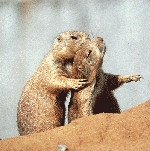 At first glance Prairie dogs (Cynomys ludovicianus) resemble Marmots. But they are smaller and their fur is normally shorter and straighter. Like Marmots Prairie dogs are rodents and belong to the same group, the Squirrels (Sciuromorpha). Nowadays there is the existence of five Prairie dog species established. The best-known is the Black-tailed prairie dog (Cynomys ludovicianus), the Prairie dog, which inhabited the prairies of the North American Middle West in large colonies and which also played a dominant role in many films about the prairie and its wildlife. As one can tell by its name, the Black-tailed prairie dog's last third of the tail is black. The colour of the rest of the fur varies from yellow-grey to brown with speckles. Prairie dogs are up to 35 cm long and reach weights of about 1,5 kg. According to their habitat the Prairie dogs' favourite food is grass.
At first glance Prairie dogs (Cynomys ludovicianus) resemble Marmots. But they are smaller and their fur is normally shorter and straighter. Like Marmots Prairie dogs are rodents and belong to the same group, the Squirrels (Sciuromorpha). Nowadays there is the existence of five Prairie dog species established. The best-known is the Black-tailed prairie dog (Cynomys ludovicianus), the Prairie dog, which inhabited the prairies of the North American Middle West in large colonies and which also played a dominant role in many films about the prairie and its wildlife. As one can tell by its name, the Black-tailed prairie dog's last third of the tail is black. The colour of the rest of the fur varies from yellow-grey to brown with speckles. Prairie dogs are up to 35 cm long and reach weights of about 1,5 kg. According to their habitat the Prairie dogs' favourite food is grass.
The Arizona black-tailed prairie dog, black-tailed prairie dog is listed as Near Threatened (LR/nt), is close to qualifying for or is likely to qualify for a threatened category in the near future, on the IUCN Red List of Threatened Species
Namings for the blacktailed prairie dog
A young / baby of a blacktailed prairie dog is called a 'whelp or pup'. The females are called 'bitch' and males 'dog or sire'. A blacktailed prairie dog group is called a 'pack, litter (young), kennel, gang or legion'.Some facts about the
Black-tailed prairie dog
Adult weight : 1.125 kg (2.475 lbs)
Maximum longevity : 11 years
Female maturity :730 days
Male maturity : 730 days
Gestation : 30 days
Weaning : 63 days
Litter size : 4
Litters per year : 1
Interval between litters : 365 days
Weight at birth : 0.016 kg (0.0352 lbs)
Weight at weaning : 0.148 kg (0.3256 lbs)
Basal metabolic rate : 2 W
Body mass : 1.112 kg (2.4464 lbs)
Links
Prairie dog hunting - information when to hunt, what to take care for, and what you are going to expect when hunting for prairie dog.
Custom Search